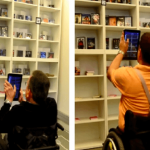 Augmented reality has become increasingly powerful in the past year as the technology gradually moves from gimmick status to something more worthwhile. One of the more interesting applications attempts to make the shopping experience more friendly for disabled shoppers.
Augmented reality has become increasingly powerful in the past year as the technology gradually moves from gimmick status to something more worthwhile. One of the more interesting applications attempts to make the shopping experience more friendly for disabled shoppers.
This is a particular issue, as the shopping experience is not generally designed with disabled people in mind, and research suggests that many dislike asking for assistance when shopping. Getting help from technology however was different, so the researchers set about designing just that.
Augmented shopping
They set about developing a pilot that utilized augmented reality to help people with three different levels of impairment.
The team developed an app for the first group and tested it in a dummy store setup. When the consumer entered the store, they loaded the app and it presented them with a virtual replica of the store. When the consumer came upon something they liked in the store, they pointed their device at it. The shelves, which were equipped with augmented reality, when communicated their contents to the device.
The information on the app was updated in real time, complete with information such as price and expiry date. As soon as the shoppers had filled their virtual baskets and were ready to check out, staff would collect each item for them, and process them.
When the test subjects were quizzed after the experiment, they revealed they felt more independent than they normally would when shopping. It was an experience more akin to that of online shopping, but in the real world.
“These interfaces are helpful to me to do shopping by myself without asking or requiring the assistance of other people. I would like to have it available at real shops, and think that getting used to something like this is very easy, and it is an opportunity to be more independent,” one participant said.
Suffice to say, a system like this is some way from entering the market, let alone the mainstream, with the kind of smart shelves used in the study considerably more expensive than existing systems. There are positive signs however, with many retailers beginning to install such shelving to help them with both stock control and theft prevention. If such an infrastructure begins to exist, then piggybacking such a system on top would be much easier.
The researchers plan to develop a more realistic shop to test the technology more thoroughly, before hopefully beginning to roll it out in a live retail environment. It will be fascinating to track and see just how successful they prove to be.
Check out the video below to see the system in action.